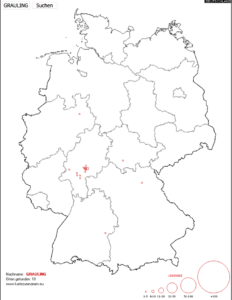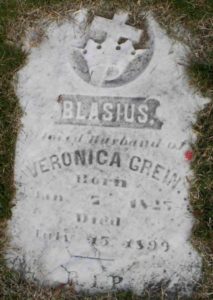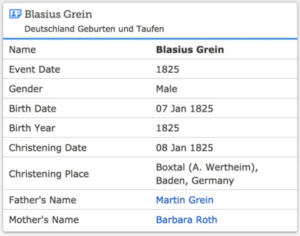Finding German Immigrant Town of Origin, Part 2 : Advanced Strategies
 14
14Dec
If you have gone through all the records listed in part 1 and are still without a town of origin for your immigrant ancestor, you will need to implement one or more advanced strategies.

Determine surname distribution
While often this is one of the least reliable strategies it is definitely worth remembering. If you have a reasonably rare German surname, you can use a website like kartezumnamen.eu to determine where, in Germany, the surname is most common. There are a few websites like this. Those that existed at the time of writing this article may be different than those that exist when you are reading this. You may have to search the internet for terms like German surname distribution. For example, a relatively rare surname like Grauling pulls up one distinct area where the surname is popular. To be effective, this strategy must be paired with the matching information strategy discussed later.
Research other related immigrants and family members
The term “related immigrants” in this case includes spouses, siblings, parents, children, cousins, neighbors, and members of the same church. The term “family members” in this strategy includes immediate family members, but could also involve others such as grandchildren of the immigrant. This strategy consists of searching actual relatives, and the advanced genealogical method often referred to as the FAN principle (friends, associates, neighbors). These could be looked at as separate strategies, but they have significant overlap in the principles relevant to finding your ancestor’s town of origin. From this list you can tell that this could be a time-consuming strategy. If you do it right, it should be quite time consuming. For all of these individuals, you would go through all the record types listed in the first part of this article. You would start with immediate family members who you have discovered were also born in Germany. This would typically be the immigrant’s spouse, their parents, or their children. If that yields no specific town of origin, you would research close associates to them such as neighbors, those who immigrated on the same boat at the same time, and those who attended the same church. These could each be looked at as their own sub-strategies, though the process will be more or less similar. Often, multiple strategies will play off of each other in order to successfully determine the correct town of origin. If you find a town of origin for someone else with whom your ancestor is associated, you cannot assume that your ancestor is from the same town. However, you can implement the next strategy on matching information.
Matching information to a family in Germany


The complexity of this strategy greatly varies from case to case. A simple example follows. If you have a German immigrant ancestor with a relatively rare name like Blasius Grein, their exact birth date which appears as 7 January 1825 on a headstone, and a census record saying he was born in the German state of Baden, this could be enough. In this actual instance, it was possible to find this ancestor in a collection of indexed German church records on FamilySearch.org. You must be especially careful with the strategy because German names may be much more common than you anticipate, so you may assume that a matching name of someone born in Germany is your ancestor when he or she is not. In this specific example, it was possible to determine that the name was relatively rare, that the state was correct, and that the birth date was an exact match. This was enough to create confidence that the correct ancestor had been located. The discovered indexed record provided the town of origin, and then those records could be searched directly on microfilm to trace the ancestry for multiple generations. The general principles will remain the same for more difficult cases. You must match up enough known information with information you find on a record created in Germany to be confident that the two represent the same individual.
There is quite a long list of things you will want to be aware of and compare—everything really. Did the German church records mention they emigrated (German church records sometimes include marginal notes of emigration to “Amerika”)? Can you obtain copies of official emigration papers from the state archive in Germany (such records often exist) that match up with your best information about when the family arrived in the United States? Did the possible family in Germany disappear from the church books at or before the supposed emigration (if they were still in Germany after your family appeared in the United States, then this family is ruled out from being yours)? If there was group migration like a parent and spouse, do all known bits of information about each person match up? For example, even if you are lacking an exact date of birth for your immigrant ancestor, but you know a month of birth (perhaps from the 1900 census) for his father who also immigrated, you may be well on your way with this strategy. Does the possible match for a man you found of the same name in Germany have a father with the same name as your ancestor’s father in the United States? Was that father born in the correct month and year? The more pieces of information that match, the more confident you can be that you have located the correct family. Once you are confident that you know their town of origin, you can trace their ancestry as far as the German records will go.
Michael
26 October 2018
At Price Genealogy we work with several expert German researchers who can help you solve the puzzles in your German ancestry.
